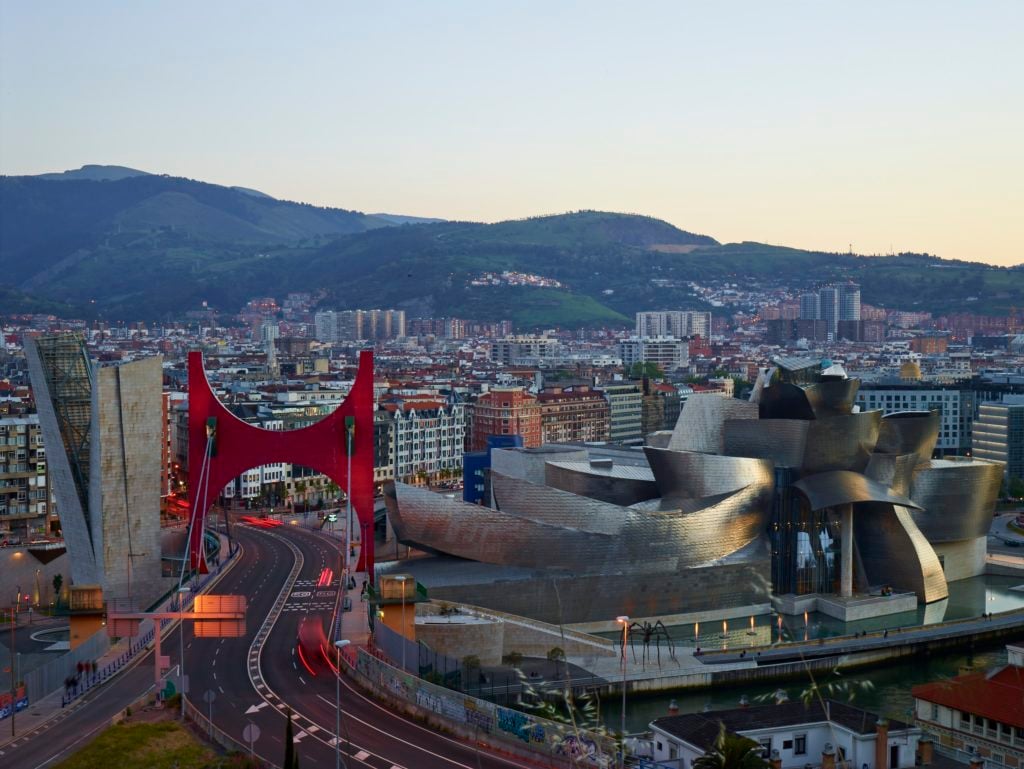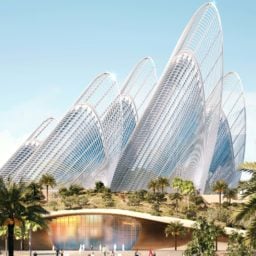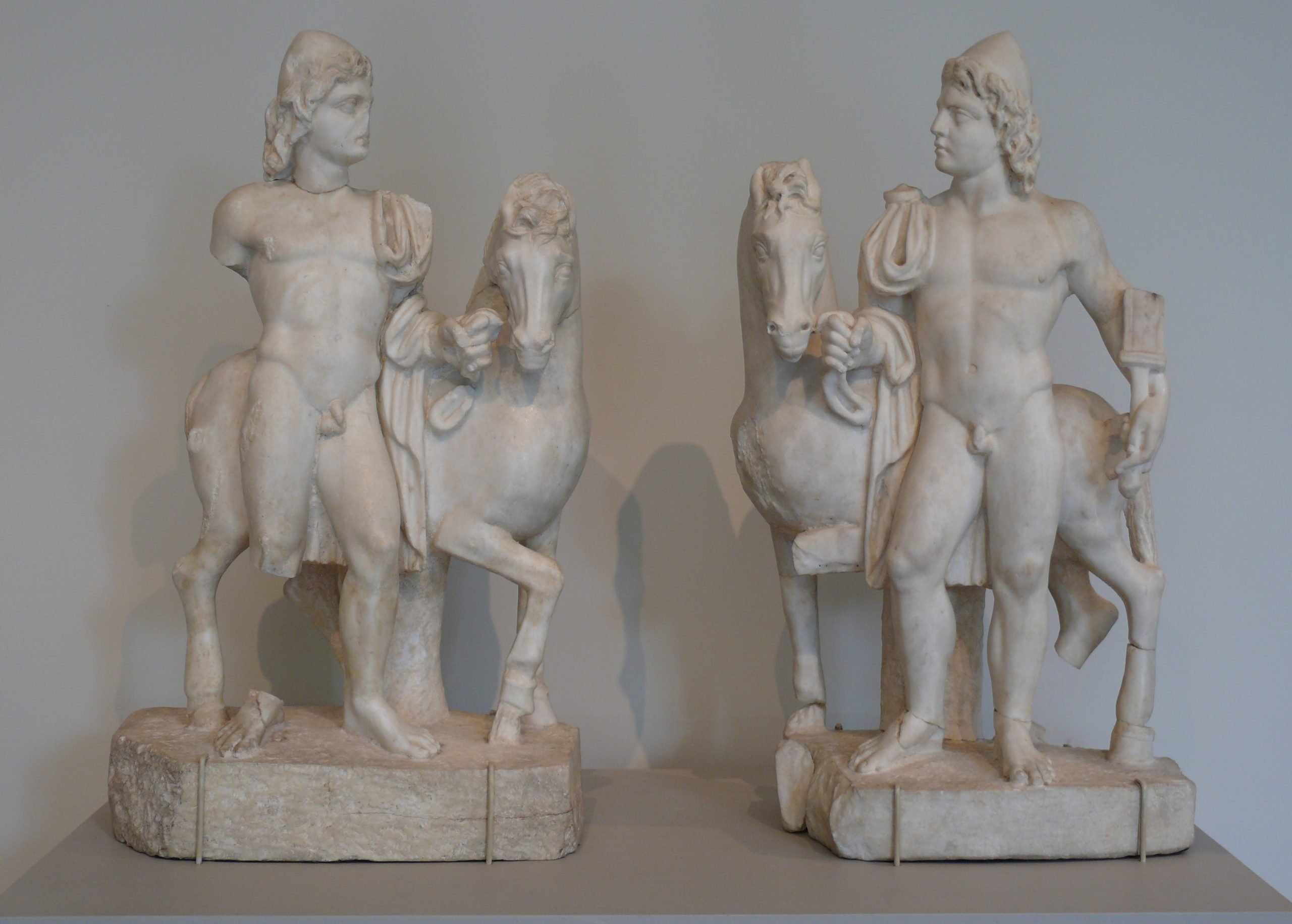Frank Gehry may be the architect most associated with Bilbao, but he is not the only one. Stand by the Basque city’s state-of-the-art football stadium—built at a cost of €211 million, half of it from public funds—and look down to the abandoned industrial buildings by the Nervión river, 30 meters below. Zorrotzaurre is the latest area of the former port city to be earmarked for redevelopment, under a master plan by the late British-Iraqi architect Zaha Hadid.
It is two kilometers around the river from Bilbao’s most famous landmark, the Guggenheim Bilbao, and it gives a flavor of how grim the site must have looked before the landmark museum’s arrival. During the 1980s, the city’s industries—iron, steel, and shipbuilding—were in decline. At its worst, unemployment hit 25 percent and—after decades of insurrection—a low point was reached when the Basque paramilitary group ETA murdered three police officers with a car bomb in the city in 1989. The river environment was polluted, blighted by gridlocked traffic and crumbling warehouses.
Today, the Frank Gehry-designed museum is the jewel in Bilbao’s cultural crown, a folded, titanium-clad “ship” nestling low in the water, next to the La Salve roadbridge, on an attractive riverfront walkway. Since it opened in 1997, it has captured local and international imaginations. For the traveling public, it is a spectacular—and Instagramable—contemporary art museum. For politicians, city planners, architects, and museum directors, it represents the ability of cultural institutions to regenerate run-down regions. This week, invited guests, journalists, and regional dignitaries will gather for five days of events to celebrate its opening 20 years ago.

A view of the construction in progress. © FMGB Guggenheim Bilbao Museoa, 2017.
Yet for all its fame, there are many who ask if so-called the “Bilbao effect” is real, and if so, if it is easily repeatable. Was the Guggenheim Bilbao a unique combination of a project at the right time and in the right place—a great architect and daring museum combined with an unusually forward-looking regional government willing to invest? Have the reasons for its transformative effect been misunderstood, explaining why its model has been frequently imitated but its extraordinary success rarely replicated?
The questions are pertinent in light of the opening next month of the Louvre Abu Dhabi, the first of a trio of museums involving international partnerships and striking architecture planned for the United Arab Emirates’s new cultural district Saadiyat Island. (The others are the Guggenheim Abu Dhabi and the Zayed National Museum, which is less obviously branded but has nonetheless had significant input from the British Museum.)
The Beginning of Bilbao
The Guggenheim Bilbao was the result of a partnership between the Guggenheim museum in New York and the governments of the city of Bilbao and the Basque region. The project was masterminded by the Guggenheim’s maverick and controversial director, Thomas Krens, who was looking for ways to expand the museum and stabilize its finances. Along with Bilbao, he would soon propose branches in New York’s SoHo and outposts in Berlin and Los Angeles, though all three were less ambitious than the museum in Spain.
While figures vary, according to a 2007 report by a Basque economist published by the American Association of Museums, the start-up costs for the Bilbao project were almost $230 million (€195 million). Beatriz Plaza, a professor of economics at the University of the Basque Country, broke down the fees: $12.1 million for the architect Frank Gehry, $6.4 million for executive architect IDOM, $100.8 million for construction, $24.7 million to the Solomon R. Guggenheim Foundation to run the museum, $9.9 million for the land, $44.5 million to start the collection, and $30.3 million for other operating costs.
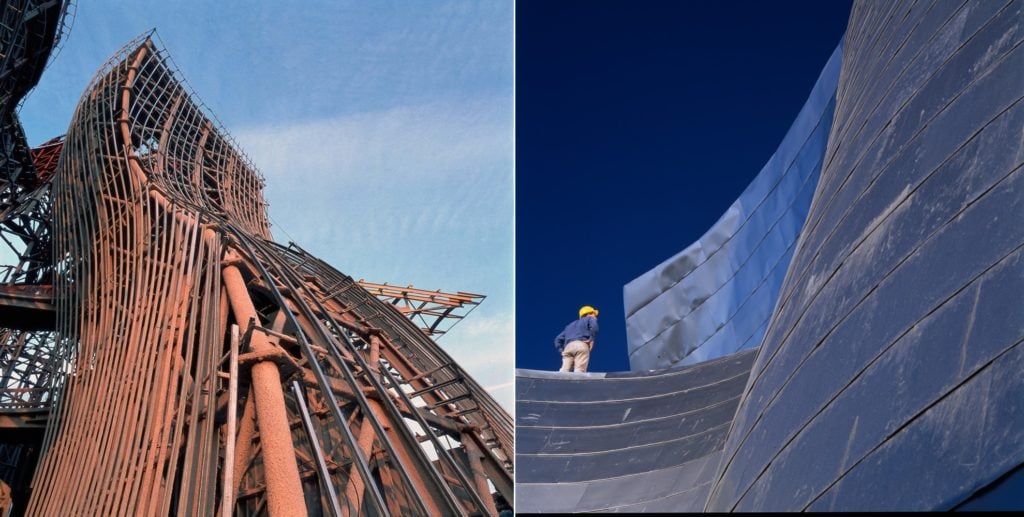
Construction of the Guggenheim Bilbao, 1993–1997. © FMGB Guggenheim Bilbao Museoa, 2017.
The price was high. But as Joseba Arregi, then the Basque minister of culture, said at the time, the sum was equal to less than a kilometer of new highway. In 1986, Spain joined the European Union, giving regions like the Basque country access to very large European regional and structural funds, as well as private sector investment from the likes of the BBVA (Banco Bilbao Vizcaya Argenteria), Spain’s second largest bank. The region responded by setting up new agencies to smooth its path from an industrial to a service economy. One key project was the regeneration of the Abandoibarra area along the former docks, of which the Guggenheim Bilbao was a part.
In the years since the opening of the Guggenheim Bilbao, the returns have been significant. The museum says it has attracted 20 million visitors (more than 60 percent from overseas) to a city with only 350,000 inhabitants. The project and its ripple effects have created more than 5,000 local jobs and generated €650 million of additional revenue for the Basque treasury.
The Guggenheim’s current director, Richard Armstrong, tells artnet News that the Guggenheim Bilbao transformed not only the way that outsiders thought about the city, but also the way the city regarded itself. “The big success of the Guggenheim Bilbao is that it demonstrably shows the impact that the visual arts can have on a city’s capacity to attract cultural visitors and at the same time positively change its own psychology,” he says. “In the 1990s, the city was hard to get to and inward-looking, it wasn’t ‘legible’ for the foreign visitor.”
From Skepticism to Celebration
Prior to opening, there was widespread skepticism about the project, especially in New York. The Austrian-born curator Max Hollein, now director of the Fine Arts Museums of San Francisco but then a young staffer at the Guggenheim, recalls: “Three years before opening, very few people thought it would be a success. Trustees, the media, people in the new architecture scene, didn’t take it seriously. There were a lot of naysayers, but Tom [Krens] held his course.”

Frank Gehry, Guggenheim Museum Bilbao (2009). Courtesy of Gemini G.E.L.
Opinion started changing as the museum neared completion. One month before the opening, an article by the legendary New York Times architecture critic Herbert Muschamp appeared under the headline, “The Miracle in Bilbao.” He wrote: “The miracle taking place here, however, is not Gehry’s building, wondrous as it is. The miraculous occurrence is the extravagant optimism that enters into the outlook of those who have made the pilgrimage [just to see the construction].”
Others, however, were less enamored. In 2005, a former Guggenheim lecturer, Paul Werner, published a polemical book under the title “Museum, Inc.” It crystallized the doubts of many and accused major institutions, including the Guggenheim, of ditching their intellectual missions and adopting behavior more suitable for corporations.
But for Hollein, the Guggenheim was exploring daring new options in museology as well as architecture. “Bilbao showed how inventive and challenging architecture could be and it marked a change in what museums were trying to achieve,” he tells artnet News. “Not only visitors, but professionals began to understand the museum in a much more positive sense: creating an experience that could be transformative. It was a metamorphosis from the museum as repository to a total concept of the museum.”
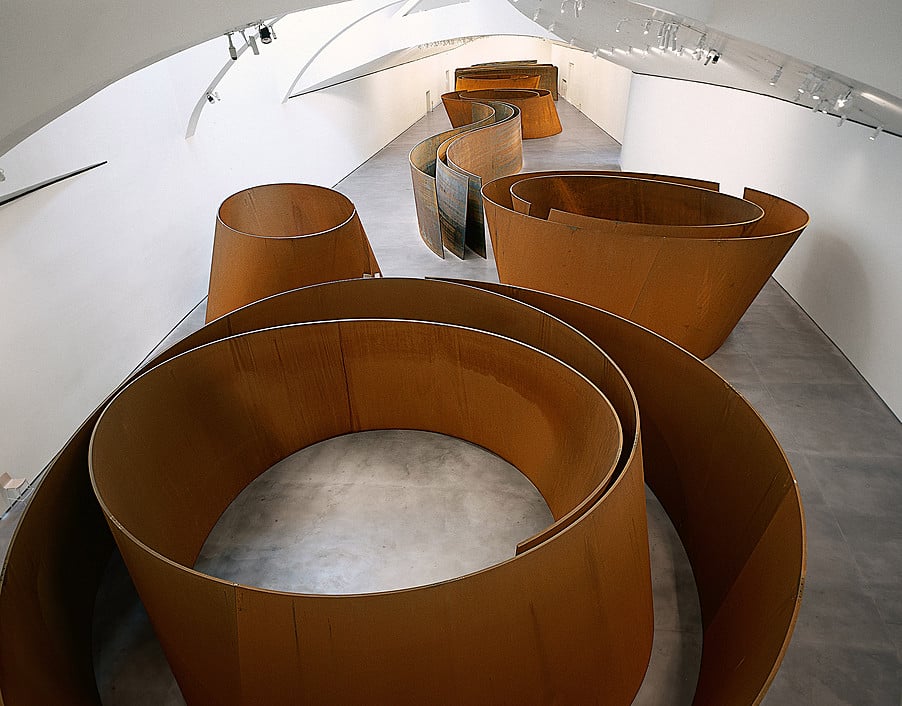
Richard Serra, The Matter of Time (2005) at the Guggenhiem Bilbao Museo in 2015. Courtesy of Richard Serra/Arts Rights Society, New York.
It also showed the ability of museums to leverage themselves as what Hollein calls “creators of credibility”—or what others call brands. This point has not been lost on institutions such as the V&A, Smithsonian, Pompidou and Louvre, all of which have worked or are working on creating international, branded extensions.
“The Guggenheim realized it had a name that stands for a certain kind of museum ideology. One of its achievements at the time was to transform the perception of itself in Europe, where it became seen one of the pre-eminent institutions in the world,” says Hollein. Armstrong agrees. “Before that, we were a small US institution with a beautiful space in Venice.”
Charting the ‘Bilbao Effect’
Since the Bilbao, a raft of museum openings and massive extensions across the world have hired high-profile architects and sought to drive tourism, regeneration, or other social agendas. These include, to name only a few, Santiago Calatrava’s Milwaukee Art Museum, Gehry’s MARTa Herford in Germany and LVMH museum in Paris, Daniel Libeskind’s Denver Art Museum extension, Zaha Hadid’s MaXXI in Rome, and Peter Cook and Colin Fournier’s Kunsthaus Graz, designed to give a more forward-looking image to the medieval Austrian city.
Many prefer to downplay their debt to Bilbao, emphasizing their own local conditions. But this is a position disputed by the Museum of Modern Art’s architecture curator, Martino Stierli.

Interior of the Guggenheim Bilbao, photo: David Heald. Image courtesy of the Guggenheim.
“Bilbao and the Guggenheim were smart in realizing that what people want in a post-industrial society is global cultural tourism within an architectural experience that could be marketed easily through the photographic image,” he says. “And obviously technical innovation, computer-aided design and the use of precious building materials became immediately successful and a model for many museums. The model was clearly and directly copied, not necessarily on a formal level, but definitely conceptually.”
Many of the museums erected during the boom of the past 30 years have indeed proven successful, although none has achieved Bilbao’s international name recognition. And some have become mired in difficulty. The Santiago Calatrava-designed City of Arts and Sciences in Valencia overshot its €300 million budget by around €1 billion and the price tag still affects regional budgets today.
In the post-industrial region of Avilés, an Oscar Niemeyer-designed art museum has also struggled, even closing for a while in 2011. This checkered history may explain why the team behind northern Spain’s latest art museum, the €80-million Renzo Piano-designed Botín Centre in Santander, has been keen to say that it is “not trying to create an icon like Bilbao.”

Renzo Piano’s Centro Botín in Santander. Image courtesy of the Centro Botín.
No Repeat Performances
Meanwhile, the Guggenheim itself has found the model hard to repeat. Its branches in SoHo, Berlin, and Las Vegas have closed, while ambitious plans for a new outpost in Helsinki were caught up in local politics and abandoned last year. Feasibility studies in cities from Taiwan to Guadalajara came to nothing, while the hugely ambitious Guggenheim Abu Dhabi is stalled (according to the Guggenheim, positive announcements on the construction process are anticipated early next year).
For the cultural consultant Adrian Ellis, the founding director of the London- and New York- based AEA Consulting firm, Bilbao is a rarity. Local authorities did not assume that the museum would singlehandedly transform the city. Money has been poured into new business and training schemes, a new tram system, metro lines (designed by the top architecture firm Foster + Partners), an airport (by Calatrava), and major civic buildings, retail, and cultural centers by the likes of Philippe Starck, Rafael Moneo, and Robert A.M. Stern.
“The Guggenheim Bilbao was part an attempt to regenerate a whole city with a tourism-driven strategy,” Ellis says. “The museum was integrated into a much wider city plan including transport and hotels, and it is in a location where within two hours of cheap flights there is just the right demographic, millions of affluent, middle-class, educated people in cities like London, Paris, and Berlin.”
For all its eccentricity and risk-taking, the Guggenheim Bilbao has, meanwhile, used its cultural assets well. It has brought world-class exhibitions from its New York location and other institutions, like the Städel in Frankfurt, and built a masterpiece-laden collection of works by artists including Robert Rauschenberg, Georg Baselitz, and Anselm Kiefer. Most importantly, there is ongoing government support to fuel its ambitions: In December 2014, the partnership with the Solomon R. Guggenheim Foundation in New York was extended for a further 20 years.
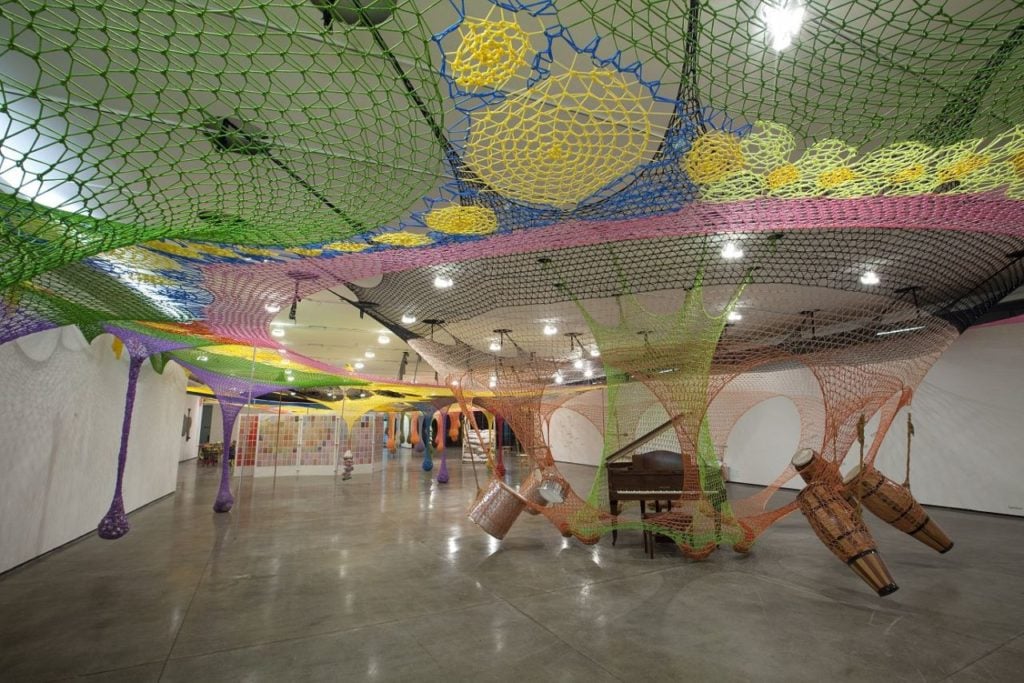
Ernesto Neto’s “Candy Man Candy” in Gallery 202 at the Guggenheim Bilbao in 2014. Image courtesy of the Guggenheim.
Bilbao was not the first modern cultural building to become an internationally recognized icon. In the economic and cultural optimism at the end of the 1950s, the Australian city of Sydney broke ground on what was to become the most famous arts building constructed in the 20th century, the Sydney Opera House. By the time it opened in 1973, times had changed and despite its iconic status, it was never to be repeated.
Similarly, the Guggenheim Bilbao was the product of a time when the benefits of free market capitalism, globalism, and the internationalization of culture seemed self-evident, and in a place where the public bodies were willing to invest over the course of more than 30 years.
Today, with rising nationalism, almost a decade of austerity, and political instability, it may be a feat that is hard to repeat. Governments are less stable and less long-term in outlook, while expensive cultural buildings may prove hard to sell to cash-strapped regional populations. It may be that, a generation after Sydney, Bilbao becomes a monument to the outward-looking, progressive and international energy that characterized the 1990s—and is now so rapidly disappearing.
Follow Artnet News on Facebook:
Want to stay ahead of the art world? Subscribe to our newsletter to get the breaking news, eye-opening interviews, and incisive critical takes that drive the conversation forward.
